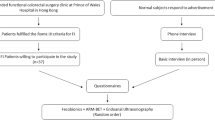Abstract
Background
Functional constipation (FC) and constipation-predominant irritable bowel syndrome (IBS-C) have significant healthcare impact. Clinical and investigative data of patients with these disorders in Indian population is scarce. We aimed to compare the clinical and anorectal manometric profile of patients with FC and IBS-C.
Methods
Consecutive patients with chronic constipation undergoing anorectal manometry (ARM) and balloon expulsion test (BET) were enrolled. Thirty healthy volunteers served as controls (HC). Functional defecatory disorder (FDD) was diagnosed according to ROME IV criteria if both ARM and BET were abnormal.
Results
Of the 231 patients enrolled (median age 47 years, 87.8% males), FC and IBS-C were diagnosed in 132 (57.1%) and 99 (42.9%) patients, respectively. Significant clinical differences between FC and IBS-C patients included older age, lower stool frequency/week, higher frequency of straining, and greater frequency of incomplete evacuation (p < 0.001). ARM revealed abnormal defecatory pattern in 55.3% (n = 73) FC patients and 47.5% (n = 47) IBS-C patients. Of them, 54.7% (40/73) of FC patients had inadequate defecatory propulsion while 89.4% (42/47) of the IBS-C patients had dyssynergic defecation (p < 0.001). Abnormal BET was seen in 67.4% of FC patients and 43.4% of IBS-C patients. Thus, FDD was diagnosed in 55.3% and 46.5% of FC and IBS-C patients, respectively. Rectal hyposensitivity was present in 60.6% of FC patients compared with 2% of IBS-C patients (p < 0.001).
Conclusions
There were significant differences in clinical and manometric profile of FC and IBS-C patients. Compared with IBS-C patients, FC patients were older, had higher prevalence of FDD, less often had dyssynergic defecation, and had higher prevalence of rectal hyposensitivity.

Similar content being viewed by others
References
Ghoshal UC. Chronic constipation in Rome IV era: the Indian perspective. Indian J Gastroenterol. 2017;36:163–73.
Ghoshal UC, Sachdeva S, Pratap N, et al. Indian consensus on chronic constipation in adults: a joint position statement of the Indian motility and functional diseases association and the Indian society of gastroenterology. Indian J Gastroenterol. 2018;37:526–44.
Rao SS, Patcharatrakul T. Diagnosis and treatment of dyssynergic defecation. J Neurogastroenterol Motil. 2016;22:423–35.
Suares NC, Ford AC. Prevalence of, and risk factors for chronic idiopathic constipation in the community: systematic review and meta-analysis. Am J Gastroenterol. 2011;106:1582–91.
Jain M, Baijal R. Dyssynergic defecation: demographics, symptoms, colonoscopic findings in north Indian patients. Indian J Gastroenterol. 2017;36:435–7.
Makharia GK, Verma AK, Amarchand R, et al. Prevalence of irritable bowel syndrome: a community based study from northern India. J Neurogastroenterol Motil. 2011;17:82–7.
Ghoshal UC, Abraham P, Bhatt C, et al. Epidemiological and clinical profile of irritable bowel syndrome in India: report of the Indian Society of Gastroenterology Task Force. Indian J Gastroenterol. 2008;27:22–8.
Nellesen D, Yee K, Chawla A, Lewis BE, Carson RT. A systematic review of the economic and humanistic burden of illness in irritable bowel syndrome and chronic constipation. J Manag Care Pharm. 2013;19:755–64.
Dennison C, Prasad M, Lloyd A, Bhattacharyya SK, Dhawan R, Coyne K. The health-related quality of life and economic burden of constipation. Pharmacoeconomics. 2005;23:461–76.
Lacy BE, Mearin F, Chang L, et al. Bowel disorders. Gastroenterology. 2016;150:1393–407.
Longstreth GF, Thompson WG, Chey WD, Houghton LA, Mearin F, Spiller RC. Functional bowel disorders. Gastroenterology. 2006;130:1480–91.
Rooprai R, Bhat N, Sainani R. Prevalence of functional constipation and constipation-predominant irritable bowel syndrome in Indian patients with constipation. Int J Basic Clin Pharmacol. 2017;6:275–85.
Ray G. Evaluation of the symptom of constipation in Indian patients. J Clin Diagn Res. 2016;10:OC01–3.
Shah N, Baijal R, Kumar P, et al. Clinical and investigative assessment of constipation: a study from a referral center in western India. Indian J Gastroenterol. 2014;33:530–6.
Lewis SJ, Heaton KW. Stool form scale as a useful guide to intestinal transit time. Scand J Gastroenterol. 1997;32:920–4.
Korah AT, Misra A, Kumar S, Ghoshal UC. Manometric spectrum of fecal incontinence in a tertiary care center in northern India. Trop Gastroenterol. 2010;31:165–8.
Rao SS, Mudipalli RS, Stessman M, Zimmerman B. Investigation of the utility of colorectal function tests and Rome II criteria in dyssynergic defecation (anismus). Neurogastroenterol Motil. 2004;16:589–96.
Rao SS, Welcher KD, Leistikow JS. Obstructive defecation: a failure of rectoanal coordination. Am J Gastroenterol. 1998;93:1042–50.
Mearin F, Ciriza C, Minguez M, et al. Clinical practice guideline: irritable bowel syndrome with constipation and functional constipation in the adult. Rev Esp Enferm Dig. 2016;108:332–63.
Zhan LX, Zhou DW, Xu GM, Li ZS, Yin N, Zhang MQ. Study on functional constipation and constipation-predominant irritable bowel syndrome by using the colonic transit test and anorectal manometry. Chin J Dig. 2002;3:128–31.
Rao SSC, Bharucha AE, Chiarioni G, et al. Functional anorectal disorders.. Gastroenterology. 2016;150:1430–42: S0016-5085(16)00175-X.
Schmulson M, Corazziari E, Ghoshal UC, et al. A four-country comparison of healthcare systems, implementation of diagnostic criteria, and treatment availability for functional gastrointestinal disorders: a report of the Rome Foundation working team on cross-cultural, multinational research. Neurogastroenterol Motil. 2014;26:1368–85.
Videlock EJ, Lembo A, Cremonini F. Diagnostic testing for dyssynergic defecation in chronic constipation: meta-analysis. Neurogastroenterol Motil. 2013;25:509–20.
Ghoshal UC, Verma A, Misra A. Frequency, spectrum, and factors associated with fecal evacuation disorders among patients with chronic constipation referred to a tertiary care center in northern India. Indian J Gastroenterol. 2016;35:83–90.
Prott G, Shim L, Hansen R, Kellow J, Malcolm A. Relationships between pelvic floor symptoms and function in irritable bowel syndrome. Neurogastroenterol Motil. 2010;22:764–9.
Patcharatrakul T, Gonlachanvit S. Outcome of biofeedback therapy in dyssynergic defecation patients with and without irritable bowel syndrome. J Clin Gastroenterol. 2011;45:593–8.
Ratuapli S, Bharucha AE, Noelting J, Harvey DM, Zinsmeister AR. Phenotypic identification and classification of functional defecatory disorders using high resolution anorectal manometry. Gastroenterology. 2013;144:314–22.
Jain M, Baijal R, Srinivas M, Venkataraman J. Clinical predictors and gender-wise variations in dyssynergic defecation disorders. Indian J Gastroenterol. 2018;37:255–60.
Posserud I, Syrous A, Lindstrom L, Tack J, Abrahamsson H, Simren M. Altered rectal perception in irritable bowel syndrome is associated with symptom severity. Gastroenterology. 2007;133:1113–23.
Burgell RE, Scott SM. Rectal hyposensitivity. J Neurogastroenterol Motil. 2012;18:373–84.
Miller R, Bartolo DC, Cervero F, Mortensen NJ. Anorectal sampling: a comparison of normal and incontinent patients. Br J Surg. 1988;75:44–7.
Shekhar C, Monaghan PJ, Morris J, et al. Rome III functional constipation and irritable bowel syndrome with constipation are similar disorders within a spectrum of sensitization, regulated by serotonin. Gastroenterology. 2013;145:749–57.
Whitehead WE, Palsson OS. Is rectal pain sensitivity a biological marker for irritable bowel syndrome: psychological influences on pain perception. Gastroenterology. 1998;115:1263–71.
Andrews C, Bharucha AE, Camilleri M, Zinsmeister AR. Rectal sensorimotor dysfunction in women with fecal incontinence. Am J Phys. 2007;292:G282–9.
Heidelbaugh JJ, Stelwagon M, Miller SA, Shea EP, Chey WD. Spectrum of constipation-predominant irritable bowel syndrome and chronic idiopathic constipation: US survey assessing symptoms, care seeking, and disease burden. Am J Gastroenterol. 2015;110:580–7.
Gwee KA, Bak YT, Ghoshal UC, et al. Asian consensus on irritable bowel syndrome. J Gastroenterol Hepatol. 2010;25:1189–205.
Zhao YF, Ma XQ, Wang R, et al. Epidemiology of functional constipation and comparison with constipation-predominant irritable bowel syndrome: the systematic investigation of gastrointestinal diseases in China (SILC). Aliment Pharmacol Ther. 2011;34:1020–9.
Rao SS, Benninga MA, Bharucha AE, Chiarioni G, Di Lorenzo C, Whitehead WE. ANMS-ESNM position paper and consensus guidelines on biofeedback therapy for anorectal disorders. Neurogastroenterol Motil. 2015;27:594–609.
Siah KT, Wong RK, Whitehead WE. Chronic constipation and constipation-predominant IBS: separate and distinct disorders or a Spectrum of disease? Gastroenterol Hepatol (N Y). 2016;12:171–8.
Acknowledgments
The authors acknowledge the support by Dr. Prerna Goyal in writing and editing the article; and technical support by Mr. Vishnath Maurya and Mrs. Neena Verma in performing anorectal manometry procedures.
Funding
This study was financially supported by the Department of Gastroenterology, Dayanand Medical College and Hospital, Ludhiana, Punjab.
Author information
Authors and Affiliations
Corresponding author
Ethics declarations
Conflict of interest
OG, MB, and AS declare that they have no conflict of interest.
Ethics statement
The authors declare that the study was performed in a manner conforming to the Helsinki declaration of 1975, as revised in 2000 and 2008 concerning human and animal rights, and the authors followed the policy concerning informed consent as shown on Springer.com.
The study has been approved by the institutional ethics committee and has been performed in accordance with the ethical standards as laid down in the 1964 Declaration of Helsinki and its later amendments.
Informed consent
Informed consent was obtained from all individuals.
Disclaimer
The authors are solely responsible for the data and the content of the paper. In no way, the Honorary Editor-in-Chief, Editorial Board Members, or the printer/publishers are responsible for the results/findings and content of this article.
Additional information
Publisher’s note
Springer Nature remains neutral with regard to jurisdictional claims in published maps and institutional affiliations.
Rights and permissions
About this article
Cite this article
Goyal, O., Bansal, M. & Sood, A. Clinical and anorectal manometry profile of patients with functional constipation and constipation-predominant irritable bowel syndrome. Indian J Gastroenterol 38, 211–219 (2019). https://doi.org/10.1007/s12664-019-00953-8
Received:
Accepted:
Published:
Issue Date:
DOI: https://doi.org/10.1007/s12664-019-00953-8




